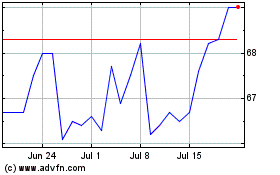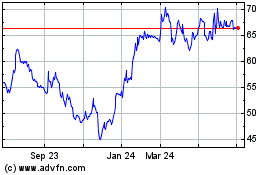Antisoma announces AS1413 and AS1411 presentations at EHA
June 14 2010 - 2:01AM
UK Regulatory
TIDMASM
London, UK, Cambridge, MA, and Barcelona, Spain: 14 June 2010 - Cancer drug
developer Antisoma plc (LSE: ASM; USOTC: ATSMY) announces that five
presentations, including an oral presentation, supporting the development of
AS1413 (amonafide L-malate) and AS1411 were presented over the weekend at the
European Hematology Association (EHA) meeting in Barcelona. All are available on
Antisoma's website at http://www.antisoma.com <http://www.antisoma.com/>.
Details of the presentations can be found below.
Enquiries:
Antisoma plc:
Glyn Edwards, CEO
Daniel Elger, VP Marketing & Communications +44 (0)7909 915 068
Details of the presentations at EHA
AS1413
#0079 The presence of P-glycoprotein (MDR1) affects the ability of AML patients
to achieve complete remission; results of a meta-analysis of the literature;
Marie et al. (poster)
#0650 Treatment-related AML and AML evolving from MDS: Similar outcomes
following treatment with amonafide + cytarabine; Sekeres et al. (poster)
#0457 The novel DNA intercalator amonafide (AS1413) disrupts the cell cycle by
mechanisms distinct from those of Topo II inhibitors daunorubicin and etoposide;
Senderovich et al. (poster)
AS1411
#1119 Long-term outcomes of responders in a randomized, controlled phase II
trial of aptamer AS1411 in AML; Stuart et al. (oral presentation)
#0643 Gene expression analysis in AML cell line MV4-11 following treatment with
the anti-cancer aptamer AS1411 Senderovich et al. (poster)
About AS1413 (amonafide L-malate)
AS1413 (amonafide L-malate) was added to Antisoma's pipeline through the
acquisition of Xanthus Pharmaceuticals, Inc. in June 2008. AS1413 is a novel DNA
intercalator that induces apoptotic signalling by blocking topoisomerase II
binding to DNA. This differs from the action of classical topoisomerase II
inhibitors, which induce apoptosis by causing extensive DNA damage. A further
distinctive feature of AS1413 is its ability to evade Pgp and related
transporters responsible for multi-drug resistance (MDR). A pivotal phase III
trial (ACCEDE) is evaluating AS1413 as a treatment for secondary AML, a
condition often associated with MDR and in which outcomes with currently
available treatments are poor. Earlier this month, the US Food and Drug
Administration granted AS1413 Fast Track status for the treatment of secondary
AML.
About AS1411
AS1411 was originally developed by Dr Paula Bates, Dr John Trent and Prof.
Donald Miller at the University of Alabama and later at the University of
Louisville. Antisoma added AS1411 to its pipeline when it acquired the
Louisville-based company Aptamera Inc. in 2005. AS1411 belongs to a new type of
drugs called aptamers. These are short pieces of DNA or RNA that fold into
three-dimensional structures capable of targeting particular proteins. AS1411 is
a DNA aptamer that binds to nucleolin, a protein expressed in the nucleus of all
cells but which in cancer cells is also exposed on the cell surface, providing a
basis for specific targeting by AS1411. When AS1411 binds to nucleolin on cancer
cells, it is internalised and causes apoptosis through interference with various
functions of nucleolin. AS1411 is being evaluated in a phase IIb trial in
patients with relapsed and refractory AML.
About Antisoma
Antisoma is a London Stock Exchange-listed biopharmaceutical company that
develops novel products for the treatment of cancer. The Company has operations
in the UK and the US. Please visitwww.antisoma.com <http://www.antisoma.com/>
for further information about Antisoma.
[HUG#1423501]
Sigmaroc (LSE:SRC)
Historical Stock Chart
From Mar 2024 to Apr 2024

Sigmaroc (LSE:SRC)
Historical Stock Chart
From Apr 2023 to Apr 2024
